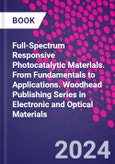Full-Spectrum Responsive Photocatalytic Materials: From Fundamentals to Applications provides a comprehensive overview on the design, synthesis concepts, mechanisms, characterization techniques, and advances and limitations in applications of full-spectrum responsive photocatalytic materials. The book starts with the fundamentals of full-spectrum responsive materials. It then discusses the problems of most semiconductors that are not active in the whole solar spectrum and explains the benefits of utilizing full-spectrum responsive photocatalysts. Other sections describe examples of full-spectrum responsive photocatalysts classified by material types and provide the design principles and characterization protocols for these promising materials.
Photocatalysis technology based on semiconductor materials holds great promise in various fields due to its potential advantages in energy-saving, cost and environmental impact. Maximizing the utilization of solar energy is always the target of pursuits in the areas of photocatalysis, and understanding and constructing appropriate full-spectrum (UV-VIS-NIR) responsive photocatalytic materials offer ways to better realize the practical utilization of photocatalysis.
Please Note: This is an On Demand product, delivery may take up to 11 working days after payment has been received.
Table of Contents
1. Photochemistry: from basic principles to photocatalysis2. Introduction of full spectrum responsive photocatalytic materials
3. Strategies to fabricate full spectrum responsive photocatalysts
4. Synthesis of full spectrum responsive photocatalysts
5. Characterization techniques for full spectrum responsive photocatalysts
6. Applications in environmental remediation
7. Applications in energy conversion
8. Novel applications in drug-free sustainable photocatalytic cancer therapy
9. Conclusion and Outlook
Authors
Chuanyi Wang School of Environmental Science and Engineering, Shaanxi University of Science and Technology, Weiyang District, Xi'an, Shaanxi, P.R.China. Dr. Chuanyi Wang, Fellow of Royal Society of Chemistry, is a distinguished professor at Shaanxi University of Science & Technology (SUST), PR China, serving as an academic dean of the School of Environmental Science and Engineering. Before moving to SUST in 2017, he was a distinguished professor of Chinese Academy of Sciences (CAS), serving as Director of Laboratory of Environmental Science & Technology of Xinjiang Technical Institute of Physics & Chemistry, CAS (2010-2017). He obtained his Ph.D. degree from Institute of Photographic Chemistry (now Technical Institute of Physics and Chemistry) of CAS in 1998, worked in Germany (Institute for Solar Energy Research in Hannover and Free University Berlin) as an Alexander von Humboldt research fellow with Prof. Detlef W. Bahnemann from 1999 to 2000, and then worked in USA (Tufts University and Missouri University-Kansas City) as a research faculty from 2000 to 2010. Currently, Dr. Wang also serves as an associate editor or editorial board member for number of international journals including Environmental Chemistry Letters and Molecular Catalysis. His research interests cover ecomaterials and environmental photocatalysis. He has published over 270 papers in peer reviewed journals with an H-index of 63.https://www.scopus.com/authid/detail.uri?authorId=55796485900 Yanyan Duan Guangdong Engineering Technology Research Center for Environmental Purification and Functional Materials, Guangzhou Institute of Industrial Intelligence, Guangzhou, China. Dr. Yanyan Duan received her PhD degree from IMDEA Materials Institute/Universidad Polit�cnica de Madrid, Spain in 2022. She received her master's degree from the University of Chinese Academy of Science (CAS) on 2017. She worked as a research assistant at Shenyang Institute of Automation, Guangzhou, CAS from 2017 to 2018. Her main research background lies in the area of photocatalysis and light emitting devices.
https://www.scopus.com/authid/detail.uri?authorId=57218330265 Lan Wang School of Environmental Science and Engineering, Shaanxi University of Science and Technology, Weiyang District, Xi'an, Shaanxi, P.R. China. Prof. Lan Wang received her Ph.D. from the Xinjiang Technical Institute of Physics & Chemistry of the Chinese Academy of Sciences in 2012. From 2012 to 2019, she worked in Xinjiang Technical Institute of Physics & Chemistry of the Chinese Academy of Sciences as an associate professor. She was?appointed?as a professor in 2019 at the School of Environmental Science and Engineering, Shaanxi University of Science and Technology, PR China. Dr. Wang's research focuses on better understanding of water pollution problems and developing green chemistry, renewable energy solutions to them for ensuring the sustainability of energy resources, both depletable and renewable. Toward that end, she has developed new clay-based 2D heterogeneous nanocatalysts by green synthetic strategy and applied in wastewater treatment by photocatalytic oxidation, and fabricated eco-friendly and portable nanomaterials based on natural polymer.
https://www.scopus.com/authid/detail.uri?authorId=57189297900 Qiuhui Zhu School of Ecology and Resource Engineering, Wuyi University, China. Qiuhui Zhu is a PhD candidate in the School of Environmental Science and Engineering, Shaanxi University of Science and Technology under the supervision of Prof. Chuanyi Wang. Meanwhile, he is studying at Queen's University Belfast as a visiting scholar under the supervision of Prof. Peter K. J. Robertson. His research interest mainly focuses on the design and synthesis of full-spectrum bismuth-based photocatalysts and piezo-photocatalysts for environmental remediation and energy conversion.








